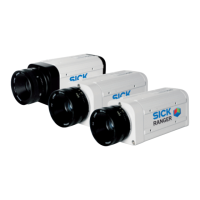Reference Manual Chapter 5
Ranger E/D
©SICK AG • Advanced Industrial Sensors • www.sick.com • All rights reserved 55
Configuring Ranger E and D
5.9.2 Color Channel Registration
The ColorRanger makes measurements for the three color channels simultaneously, but
uses different rows on the sensor. Therefore each color channel depicts different cross-
sections of the object in front of the camera. Each scan will acquire data from slightly
different parts of the object. As the object passes in front of the camera, each position on
the object is measured for red, green and blue colors at slightly different times.
When the entire object has passed the camera, it is captured in three individual images
that are slightly shifted with respect to each other. The distance that the images are
shifted is small, but must still be compensated for to avoid color artifacts and get high
quality color images.
This compensation is known as color channel registration and basically means that the
images are shifted before being combined into one color image. To do this, we need to
know the distance that the images are shifted.
Red channel
Green channel
Blue channel
t
1
t
2
t
3
t
1
t
2
t
3
Figure 5.18 –Illustration how the 3 color rows, placed with intervals on the sensor, when
scanning an object gives an image with misregistration.
Figure 5.19 –Illustration of unregistered (left) and registered (right) color scanned by a
Ranger E camera. Note the false color edges on the letters in the unregis-
tered image.
Registration and variations in speed
The distance to shift each color channel depends on the geometry, the profile rate, and the
object speed. Should any of these vary during the measurement, the distances that the
color channel images need to be shifted will also vary.
Variations in profile rate and object speed can be handled by using an encoder in the
following ways:
Red channel
Green channel
Blue channel

